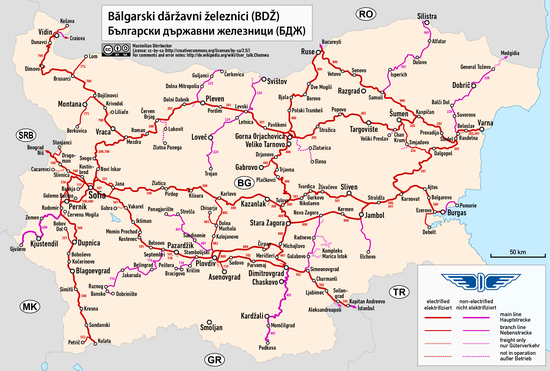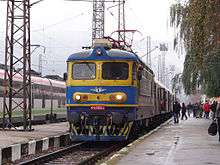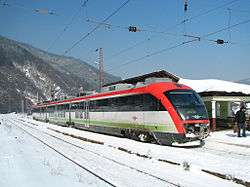Bulgarian State Railways
The Bulgarian State Railways (Bulgarian: Български държавни железници, Balgarski darzhavni zheleznitsi, abbreviated as БДЖ, BDZ or BDŽ) are Bulgaria's state railway company and the largest railway carrier in the country, established as an entity in 1888. The company's headquarters are located in the capital Sofia. Since the 1990s the BDŽ has met serious competition from automotive transport. Up to 2002 the company also owned/managed the railway infrastructure in the country, when according to EU regulations a new state company, the National Railway Infrastructure Company, was founded and became the owner of the infrastructure.
Native name | Холдинг Български държавни железници |
|---|---|
Romanized name | Balgarski darzhavni zheleznitsi Holding |
| Government-owned corporation | |
| Industry | Transport |
| Founded | 1888 |
| Headquarters | , |
Area served | Bulgaria |
Key people | Nikola Vasilev |
| Services | Passenger and freight transport |
Number of employees | 17,867 |
| Website | www.bdz.bg |
 Map of the Bulgarian railway network | |
| Overview | |
|---|---|
| Locale | Bulgaria |
| Dates of operation | 1888– |
| Technical | |
| Track gauge | 1,435 mm (4 ft 8 1⁄2 in) standard gauge |
| Electrification | 25 kV AC, 50 Hz OHLE |
| Length | 4,070 km (2,529.0 mi) (as of 31 Dec 2012) |
Bulgaria is a member of the International Union of Railways (UIC). The UIC Country Code for Bulgaria is 52.
History
The Ruse – Varna, the first Bulgarian railway line, was started in 1864. The Turkish government had commissioned for it an English company managed by William Gladstone, a politician, and the Barkley brothers, civil engineers. The line, which was 223 km long, was opened in 1866.
In 1870 Baron Maurice de Hirsch started the construction of the Constantinople – Belovo railway line, completed three years later.
In 1885, the National Assembly passed the Railway Act, according to which railways in Bulgaria were considered state property and were to be operated by the state. In 1888 Stefan Stambolov’s government expropriates the Vakarel – Belovo railway line (built and previously operated by Vitalis) and started operating it. On 1 August, the whole of the Tsaribrod (Dimitrovgrad, Serbia) – Sofia – Belovo railway line was opened for international traffic. The state bought off the Ruse – Varna railway line and started operating it on 10 August. The Bulgarian State Railways were therefore established, based on the Tsaribrod – Sofia – Belovo and Ruse – Varna railway lines. An independent Ministry of Railways, Post Offices and Telegraphs was established in 1912, followed by the State Railway School in 1923.
The next major railway line to be opened was the sub-Balkan railway line, in 1952.
Diesel traction was introduced in 1963 for train traffic with the diesel-hydraulic B′B′ locomotives (class 04), built by SGP. The first electrified line, Sofia – Plovdiv, entered into operation in the same year with the new then class 41, built by Škoda. The first doubled track line, the Sindel – Varna, was completed one year later.
In 1978 operations started on the Varna - Illichivsk ferry line with four train ferries capable of carrying each 104 four-axle 1,520 mm (4 ft 11 27⁄32 in) wagons. Break of gauge facility was constructed in Beloslav
On 1 January 2002, the new Railway Transport Act entered into force, passed by the National Assembly of the Republic of Bulgaria, according to which the National Company Bulgarian State Railways were split into two separate enterprises – a railway carrier (Bulgarian State Railways EAD) and an infrastructure enterprise (Railway Infrastructure National Company)
The European Commission formally warned Bulgaria in May 2010 for failure to implement the First Railway rules on track access charges.[1] In October 2010 further restructuring was announced, with BDŽ EAD becoming a holding company, and all rolling stock allocated to passenger & freight subsidiaries.[2]
Company structure


Since the last reforms in 2007, a new organisational structure has been approved.
BDŽ Inc. (a holding company with one shareholder, the Republic of Bulgaria)
- BDŽ Putnicheski Prevozi Ltd. - responsible for the passenger services. The company carried 31.36 million passengers in 2009.
- BDŽ Tovarni Prevozi Ltd. - Freight operations and expedition with subsidiary BDZ SPED Ltd. The company carried 13.3 million tonnes of freight in 2009 in 3.1 million tonne-kilometers. Privatisation was attempted in 2012, but called off in 2013 due to financial problems.[3]
- BDŽ Traktzionen Podvizhen Sustav Ltd. - locomotive management and servicing.
- BDŽ-Koncar Inc. - joint venture between BDŽ EAD and KONČAR Group from Croatia with main scope of work locomotive repairs and modernization.
Still there are many problems with the organisational structure of the holding. In order to optimise the running costs many of the employees from the administration should be laid off. There is an evident lack of effectiveness in the administration and the main goal of the Ministry of Transport, Information Technologies and Telecommunication is to make the company profitable.
Current traction
| Class | Manufacturer | Traction Type | Notes |
|---|---|---|---|
| 06 | Electroputere – Craiova | Diesel-electric | |
| 07 | Luhanskteplovoz | Diesel-electric | Ludmilla (locomotive) The most famous locomotives built in the Soviet Union. Same as DB Class 232 |
| 10 | Siemens AG | DMU-2 | Desiro Modern diesel-hydraulic multiple-units. |
| 30 | Siemens AG | EMU-3 | Desiro Modern 3 car electric multiple units |
| 31 | Siemens AG | EMU-4 | Desiro 4 car version of class 30 |
| 32 | RVR Riga | EMU-4 | Soviet built EMUs. Soviet class ЭР25 (ER25) |
| 33 | RVR Riga | EMU-4 | Soviet built EMUs. Soviet class ЭР33 (ER33) |
| 42.1 | Škoda Works | Electric | |
| 43 | Škoda Works | Electric | |
| 44 | Škoda Works | Electric | Same as Class 43, but with electro-dynamic braking. |
| 45 | Škoda Works | Electric | Same as Class 44. Re-geared for 110 km/h operation for freight trains. |
| 46/46.2 | Electroputere – Craiova | Electric | The LE5100 are the most powerful locomotives in use by BDŽ. Similar to CFR class 40. |
| 51 | Ganz | Diesel | Similar to ZS Class 641 and MÁV Class M44. |
| 52 | VEB Lokomotiv und Electrotechnische Werke | Diesel-hydraulic | DB Class V 60. |
| 55 | FAUR | Diesel-hydraulic | The biggest number of locomotives in the BDŽ fleet. |
| 61 | Škoda Works | Electric | Shunter and light service loco. Famous amongst railfans in Bulgaria due to rarity (≈20 units) of locomotive. |
| 66 | Humboldt-Deutzmotoren A.G. | Diesel-hydraulic | Sofia Depot has one locomotive of the class, which had to be restored for shunting service in the depot, but works were stopped due to lack of financing. DR Class V20. |
| 75 | Henschel & Son | Diesel-hydraulic | 760 mm (2 ft 5 15⁄16 in) gauge locomotives used on the Septemvri – Dobrinisthe tourist-attraction line. |
| 77 | FAUR | Diesel-hydraulic | 760 mm (2 ft 5 15⁄16 in) gauge locomotive. |
| 81 | Камбарский машиностроительный завод (Kambarka Engineering Works) |
Diesel-hydraulic | 760 mm (2 ft 5 15⁄16 in) gauge shunting locomotive. Soviet class ТУ7 (TU7) |
Narrow gauge railways
The scenic Septemvri-Dobrinishte narrow gauge line was finished in 1945. It goes through the station of Avramovo, which is the highest railway station on the Balkans at 1267.4 meters. Further on, it passes through the summer and winter tourist centre of Bansko. The line is 760mm gauge, unelectrified, and is primarily served by diesel power locomotives, however there are well preserved steam locomotives that provide attraction tours. Even though it is very attractive to tourists, it is also widely used by the local inhabitants for public transport purposes.
Rail links to adjacent countries
- Greece — Kulata - Promachonas and Svilengrad - Orestiada (Note: passenger services suspended from early 2011, resumed May 2014)
- North Macedonia — via Niš in Serbia or via Thessaloniki in Greece (Note: passenger services suspended from early 2011, resumed May 2014)
- Romania — via Ruse - Giurgiu bridge over the Danube, Kardam - Negru Voda and Vidin - Calafat bridge over the Danube.
- Serbia — via Kalotina - Dimitrovgrad, Serbia
- Turkey — via Svilengrad - Kapikule
References
- "Чешка фирма строи третата част на Пловдив – Свиленград" (in Bulgarian). Plovdiv24.bg. Retrieved 2009-07-09.
- "Влак-стрела ще минава през Ботевград до 2017 г." (in Bulgarian). Botevgrad.com. Retrieved 2009-07-09.
Footnotes
- "News in Brief". Railway Gazette. 2010. Retrieved 2010-07-05.
- "Railway Gazette: BDZ becomes holding company". Retrieved 2010-11-19.
- "BDZ freight privatisation called off". Railway Gazette International. Retrieved 24 June 2013.
External links
| Wikimedia Commons has media related to Rail transport in Bulgaria. |
- Official website (in Bulgarian and English)
- Unofficial map of Bulgarian Railways (in Bulgarian and English)
- Boosting Railway infrastructure in Bulgaria (in English)
- Bulgarian Locomotive Forum (in Bulgarian, English, and German)
- Bulgarian State Railways classes linst @ Trainspo (in English)